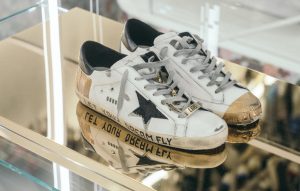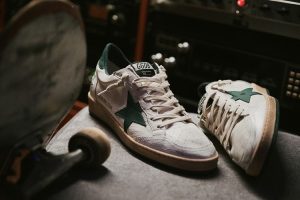Origins
Golden Goose was founded in 2000 by two Venetian designers, Alessandro and Francesca Gallo.[1] Their venture began with a collaboration with a Venetian tailor, a close friend, who crafted made-to-measure samples. Supported by a group of agents and showrooms, Golden Goose’s first collection, Spring 2001, was launched and introduced a few months later.

Since then, Golden Goose has created a “complete lifestyle” brand, combining a refined and modern style with a vintage feel supported by the Italian sartorial tradition.
Design and manufacturing
Golden Goose created a “total look” that merges American flavor with Italian wearability. Its products are Made in Italy, typically in the Veneto and Riviera del Brenta region, with other minor production sites around the peninsula. Surfaces are treated for the brand’s “lived-in” signature style.
Distribution
In 2014 Golden Goose focused its attention on retail development, opening flagship stores in venues around the world. The company’s retail network included 58 stores by the end of 2018 and grew to 100 stores worldwide by the end of 2019. Golden Goose is distributed globally, operating 158 stores covering Asia, Europe, Middle East and Americas, with direct retail stores, online, and wholesale distribution.
LAB at Milan store
On February 2, 2019, Golden Goose opened the first LAB at Milan store. The LAB, where visitors can customize their products, was born to bring the brand Venetian artisanal tradition to a retail environment. A Golden Goose craftsman shows how the products are treated and distressed by hand through professional brushes and treatments and visitors can customize their sneakers. Sneakers hang from the ceiling of the store light, a reference to the founders’ idea to leave the shoes in the sun to give the sole its yellow color.
Controversy
In 2018 Golden Goose was at the center of a social media controversy in which the brand was accused of “poverty appropriation” over a pair of $600 sneakers featuring duct-tape and scuff marks. Many people called the brand out on Twitter for “mocking poverty”. The same type of distressed shoe was first launched in a shade of pink in 2016, which also received backlash. In response, the company said it was “proud to highlight its pioneering role in the booming of the distressed look, one of the current biggest trends in fashion”, adding that the taped look on the sneakers was meant to “pay homage to the West Coast’s skater culture”.[2] The distressed design, however, was called out for being insensitive due to its expensive price and seeming “fetishizing” of poverty.[3]
Ownership
In 2010 with revenues of €30M through a worldwide top-retailers network, the company was bought by Style Capital Group. In May 2015 the majority of the company was acquired by a pool of investors led by Ergon Capital. In February 2017 The Carlyle Group acquired 100% of Golden Goose. In February 2020 Golden Goose, Permira and The Carlyle Group announced that a company backed by Permira funds agreed to acquire Carlyle’s majority stake in Golden Goose.
Milan headquarters
In the year dedicated to the celebration of its 20th Anniversary, Golden Goose opened its new headquarters in Milan at Via Ercole Marelli 10.
The architectural project consisted of the renovation of two industrial buildings, a reference to the first historical HQ in Marghera located in an old foundry. The absence of pillars in the original structure made it possible to develop a centripetal project in which everything converges towards the central patio.
The façade takes shape as two 3D parallelograms covered in black micro-perforated metal sheet (Kalzip) intersecting with one another. The largest building, developed on three levels, has an area of 3670 sqm and is dedicated to offices while the smaller one-story building of 1000 sqm is dedicated to the showroom.

The building dedicated to the offices is interspersed with four gilded alcoves in gold while in the center, a patio with a large pool of water covered with black stones evokes Japan. All around the patio, on the ground and first floor, there are work spaces and meeting rooms identified by numbers that recall important moments for the company. Room 750, for example, identifies the number of employees at the time of opening of the new HQ, while room 193 recalls the perimeter in millimeters of the golden star applied to the sneakers.
The office space is designed to focus on people and their well-being. A series of “phone booths” allow everyone moments of privacy, and a break room has table football with a gold-plated soccer table.The Dream room was designed in the image and likeness of the LABs. The CEO office, wrapped in a three-dimensional painting, was created by the New York artist Stickymonger among whose works include the decoration of an area of the World Trade Center in NY and whose giant murals transform normal spaces into dreamlike universes. The rooftop, on the second floor, has a terraced outdoor area where swings are positioned, together with the Golden Bench. The space dedicated to the restaurant with open kitchen is completely covered by Rubelli silk and a series of vintage frames on the walls narrating the company’s history from its origins. Part of the restaurant is reserved for a hydroponic garden that is harvested and used for the daily menu. An outdoor area is dedicated to an eco-mobility park, with e-bikes and electric machines available for the employees.
The smaller showroom building can be accessed through a hallway that changes every season, turning into an immersive path narrating the brand’s collection. With the aim of maintaining the original structure and highlighting the architectural space, the walls were entirely flocked and the lighting system consists of a string of 11 18-meter-long LED strips. The industrial furnishings are entirely chromed in gold. The showroom is designed as a very flexible and versatile space.
At the entrance of the headquarters, inspired architectural elements nod to the history of the brand and its Venetian roots. The entrance consists of a concrete tunnel with an iconic black and white flag on the left and a large LED wall.
The surroundings are flanked by metal carpentry characterized by V-shaped pillars while the floor was created by setting 6300 stars made of Carrara marble, recalling the technique used for historic Venetian terraces and for the mosaic design created by architect Carlo Scarpa in the Olivetti store in Venice. This space is illuminated by an expanse of lamps inspired by those of the Met Breuer in NY, a museum near our Madison Flagship store.